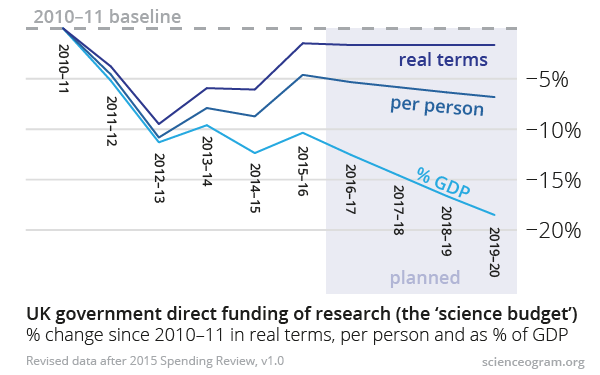Spending Review 2015: initial reaction
The Chancellor George Osborne announced this afternoon that the Science Budget would be frozen in real terms until 2020.
This appears better than the situation was in 2010, as the overall budget will no longer be eroded by steady attrition from inflation. However, there are several caveats to bear in mind. Firstly, in spite of this ‘protection’, the figures are still not encouraging. Our analysis shows:
- The Science Budget is and will remain lower in real terms than it was in 2010.
- The Science Budget is falling per person living in the UK, and as a fraction of GDP. By 2020, the Science Budget will be nearly 20% lower as a fraction of GDP than it was in 2010.

Secondly, the devil is, as always, in the detail. Given other likely changes which aren’t yet clear after today’s announcements, this graph should probably be seen as a best-case scenario for UK research.
One risk is that other types of research or items of government spending may be ‘tucked in’ to the Science Budget, reducing the amount available for current activities. One particular cause for concern is the newly announced Global Challenges Fund, which appears to allow the government to use the same money to count towards a ‘protected’ Science Budget, and its obligations towards international development. To quote from the official Spending Review document:
The Spending Review and Autumn Statement reasserts the government’s firm commitment to the UK remaining at the forefront of world science by protecting today’s £4.7 billion science resource funding in real terms for the rest of the Parliament. This includes a new £1.5 billion Global Challenges fund to ensure UK science takes the lead in addressing the problems faced by developing countries whilst developing our ability to deliver cutting-edge research. (emphasis ours)
This £1.5bn is significantly more than the £900m which will be required to compensate for the effect of inflation by 2020. At best, therefore, this represents government directing funds of around £300m per year towards global challenges, however those are chosen to be defined—something we are not in principle opposed to. However, a more cynical reading of this could be that cash for activities which are part of the current Science Budget will be appropriated to ensure that we continue to spend 0.7% of GDP on international development—apparently allowing the Government to both have its cake, and eat it.
The Spending Review also commits to investing £5bn in health R&D, and to double support for energy innovation, without specifying how exactly that money will be found. (It’s particularly surprising in the case of the commitment to health research, because the government doesn’t have any mechanism to keep track of how much it spends on particular kinds of research.)
The other huge unknown is what will happen to departmental funding of R&D, which is a significant contributor to UK research. In the aftermath of the 2010 Spending Review there were some jaw-dropping decreases—several departments including Education and CLG slashed investment by more than 50% in a single financial year. Given significant headline cuts in research-intensive departments like DEFRA—the department responsible for agriculture and the environment—how the axe falls here is definitely something to watch.
These remain uncertain times for UK research. Investment in the Science Budget is flat-lining in real terms and details remain unresolved, while departmental research will doubtless be squeezed as a new round of cuts takes hold.
That there is this much to analyse and discuss is astounding when looked at from the Scienceogram perspective: we still invest just pence per person per year researching deadly diseases and new kinds of energy. The outcome of this Spending Review isn’t as bad as many had feared, but we are certainly due some unambiguous ambition from Government, rather than details to pick over.